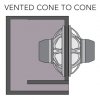I was running a 4-way active setup with two Pioneer 944 amps in my Indica.
But after 14 years the car started to show its age and was not able to take the high load from the two Pioneer amps which were pushing a 10 inch subwoofer, a pair each of 7 inch mdbass, 4 inch midrange and tweeters.
So I had to remove the two Pioneer amps and instead tried to see the possibility of using any of the numerous low profile Class D amplifier boards available.
From what I read and gathered, the ALLO Volt+ amp was the most promising, both is quality, power needs and integration.
These ready built boards perform well at 20 volt input and push out around 30 to 35 watt RMS at reasonably low THD levels and another good thing is they are stable with 4 ohm drivers. Another good thing is the current draw is only around 4 amps, so that was hardly any load as compared to the two Pioneer amps which were drawing close to 100 amps.
Now the need was for a DC to DC booster which could provide a clean output. Picked up two such mini boards from amazon. But these produced high interference and DC noise through the speakers when powered with the ALLO.
So out went these boards and in came Laptop adapters. The output was clean, no noise or interference.
Now the need was for a good 12 volt to 220 volt converter to power the laptop adapters.
I had purchased a good one several years ago to run my laptop in the car. It was rated for 300 watts, 40 amps, so that was no issue with these laptop adapters which draw less than 5 amps.
The 12/220 investor, the two laptop adapters, two ALLO boards giving 4 channels of amplification and a power strip were added to the boot on a MDF board behind the passenger seat.
I ran a 12 volt line with a 50 amp fuse direct from the battery to the 12/220 investor with a switch near the driver seat to control the input. The stable common ground was tapped from the boot section itself.
I will be adding a fan to keep the ALLO boards running cool.
The ALLO amps are driving a pair of Dayton 7 inch midbass and a pair of Dayton Reference 4 inch wideband.
The midbass is playing from 63hz at 18db slope to 315hz at 12db slope and the midrange from 315 at 12db slope to 20khz. The source is the 3-way active head unit Eclipse CD7200mkii and the Kenwood KOS-300 is used for USB integration.
The setup is without tweeters or a subwoofer at the moment.
The ALLO amps are able to,power the midbass quite well, and of course the wideband as well.


But after 14 years the car started to show its age and was not able to take the high load from the two Pioneer amps which were pushing a 10 inch subwoofer, a pair each of 7 inch mdbass, 4 inch midrange and tweeters.
So I had to remove the two Pioneer amps and instead tried to see the possibility of using any of the numerous low profile Class D amplifier boards available.
From what I read and gathered, the ALLO Volt+ amp was the most promising, both is quality, power needs and integration.
These ready built boards perform well at 20 volt input and push out around 30 to 35 watt RMS at reasonably low THD levels and another good thing is they are stable with 4 ohm drivers. Another good thing is the current draw is only around 4 amps, so that was hardly any load as compared to the two Pioneer amps which were drawing close to 100 amps.
Now the need was for a DC to DC booster which could provide a clean output. Picked up two such mini boards from amazon. But these produced high interference and DC noise through the speakers when powered with the ALLO.
So out went these boards and in came Laptop adapters. The output was clean, no noise or interference.
Now the need was for a good 12 volt to 220 volt converter to power the laptop adapters.
I had purchased a good one several years ago to run my laptop in the car. It was rated for 300 watts, 40 amps, so that was no issue with these laptop adapters which draw less than 5 amps.
The 12/220 investor, the two laptop adapters, two ALLO boards giving 4 channels of amplification and a power strip were added to the boot on a MDF board behind the passenger seat.
I ran a 12 volt line with a 50 amp fuse direct from the battery to the 12/220 investor with a switch near the driver seat to control the input. The stable common ground was tapped from the boot section itself.
I will be adding a fan to keep the ALLO boards running cool.
The ALLO amps are driving a pair of Dayton 7 inch midbass and a pair of Dayton Reference 4 inch wideband.
The midbass is playing from 63hz at 18db slope to 315hz at 12db slope and the midrange from 315 at 12db slope to 20khz. The source is the 3-way active head unit Eclipse CD7200mkii and the Kenwood KOS-300 is used for USB integration.
The setup is without tweeters or a subwoofer at the moment.
The ALLO amps are able to,power the midbass quite well, and of course the wideband as well.











